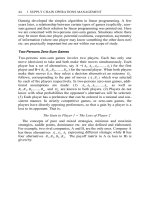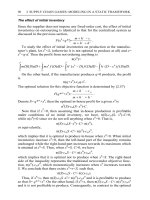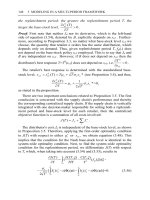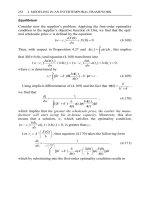Operations management heizer 6e sup07
Bạn đang xem bản rút gọn của tài liệu. Xem và tải ngay bản đầy đủ của tài liệu tại đây (378.57 KB, 48 trang )
Operations
Management
Supplement 7 –
Capacity Planning
PowerPoint presentation to accompany
Heizer/Render
Principles of Operations Management, 6e
Operations Management, 8e
© 2006
Prentice
Hall, Inc. Hall, Inc.
©
2006
Prentice
S7 – 1
Outline
Capacity
Design and Effective Capacity
Capacity and Strategy
Capacity Considerations
Managing Demand
Capacity Planning
© 2006 Prentice Hall, Inc.
S7 – 2
Outline – Continued
Breakeven Analysis
Single-Product Case
Multiproduct Case
Applying Decision Trees to
Capacity Decisions
© 2006 Prentice Hall, Inc.
S7 – 3
Outline – Continued
Applying Investment Analysis to
Strategy-Driven Investments
Investment, Variable Cost, and
Cash Flow
Net Present Value
© 2006 Prentice Hall, Inc.
S7 – 4
Learning Objectives
When you complete this supplement,
you should be able to:
Identify or Define:
Capacity
Design capacity
Effective capacity
Utilization
© 2006 Prentice Hall, Inc.
S7 – 5
Learning Objectives
When you complete this supplement,
you should be able to:
Describe or Explain:
Capacity considerations
Net present value analysis
Break-even analysis
Financial considerations
Strategy-driven investments
© 2006 Prentice Hall, Inc.
S7 – 6
Capacity
The throughput, or the number of
units a facility can hold, receive,
store, or produce in a period of time
Determines fixed costs
Determines if demand will be
satisfied
Three time horizons
© 2006 Prentice Hall, Inc.
S7 – 7
Planning Over a Time
Horizon
Long-range
planning
Add facilities
Add long lead time equipment
Intermediaterange
planning
Subcontract
Add equipment
Add shifts
Short-range
planning
Add personnel
Build or use inventory
*
Modify capacity
*
Schedule jobs
Schedule personnel
Allocate machinery
Use capacity
* Limited options exist
Figure S7.1
© 2006 Prentice Hall, Inc.
S7 – 8
Design and Effective
Capacity
Design capacity is the maximum
theoretical output of a system
Normally expressed as a rate
Effective capacity is the capacity a
firm expects to achieve given current
operating constraints
Often lower than design capacity
© 2006 Prentice Hall, Inc.
S7 – 9
Utilization and Efficiency
Utilization is the percent of design capacity
achieved
Utilization = Actual Output/Design Capacity
Efficiency is the percent of effective capacity
achieved
Efficiency = Actual Output/Effective Capacity
© 2006 Prentice Hall, Inc.
S7 – 10
Bakery Example
Actual production last week = 148,000 rolls
Effective capacity = 175,000 rolls
Design capacity = 1,200 rolls per hour
Bakery operates 7 days/week, 3 - 8 hour shifts
Design capacity = (7 x 3 x 8) x (1,200) = 201,600 rolls
© 2006 Prentice Hall, Inc.
S7 – 11
Bakery Example
Actual production last week = 148,000 rolls
Effective capacity = 175,000 rolls
Design capacity = 1,200 rolls per hour
Bakery operates 7 days/week, 3 - 8 hour shifts
Design capacity = (7 x 3 x 8) x (1,200) = 201,600 rolls
© 2006 Prentice Hall, Inc.
S7 – 12
Bakery Example
Actual production last week = 148,000 rolls
Effective capacity = 175,000 rolls
Design capacity = 1,200 rolls per hour
Bakery operates 7 days/week, 3 - 8 hour shifts
Design capacity = (7 x 3 x 8) x (1,200) = 201,600 rolls
Utilization = 148,000/201,600 = 73.4%
© 2006 Prentice Hall, Inc.
S7 – 13
Bakery Example
Actual production last week = 148,000 rolls
Effective capacity = 175,000 rolls
Design capacity = 1,200 rolls per hour
Bakery operates 7 days/week, 3 - 8 hour shifts
Design capacity = (7 x 3 x 8) x (1,200) = 201,600 rolls
Utilization = 148,000/201,600 = 73.4%
© 2006 Prentice Hall, Inc.
S7 – 14
Bakery Example
Actual production last week = 148,000 rolls
Effective capacity = 175,000 rolls
Design capacity = 1,200 rolls per hour
Bakery operates 7 days/week, 3 - 8 hour shifts
Design capacity = (7 x 3 x 8) x (1,200) = 201,600 rolls
Utilization = 148,000/201,600 = 73.4%
Efficiency = 148,000/175,000 = 84.6%
© 2006 Prentice Hall, Inc.
S7 – 15
Bakery Example
Actual production last week = 148,000 rolls
Effective capacity = 175,000 rolls
Design capacity = 1,200 rolls per hour
Bakery operates 7 days/week, 3 - 8 hour shifts
Design capacity = (7 x 3 x 8) x (1,200) = 201,600 rolls
Utilization = 148,000/201,600 = 73.4%
Efficiency = 148,000/175,000 = 84.6%
© 2006 Prentice Hall, Inc.
S7 – 16
Bakery Example
Actual production last week = 148,000 rolls
Effective capacity = 175,000 rolls
Design capacity = 1,200 rolls per hour
Bakery operates 7 days/week, 3 - 8 hour shifts
Efficiency = 84.6%
Efficiency of new line = 75%
Expected Output = (Effective Capacity)(Efficiency)
= (175,000)(.75) = 131,250 rolls
© 2006 Prentice Hall, Inc.
S7 – 17
Bakery Example
Actual production last week = 148,000 rolls
Effective capacity = 175,000 rolls
Design capacity = 1,200 rolls per hour
Bakery operates 7 days/week, 3 - 8 hour shifts
Efficiency = 84.6%
Efficiency of new line = 75%
Expected Output = (Effective Capacity)(Efficiency)
= (175,000)(.75) = 131,250 rolls
© 2006 Prentice Hall, Inc.
S7 – 18
Capacity and Strategy
Capacity decisions impact all 10
decisions of operations
management as well as other
functional areas of the organization
Capacity decisions must be
integrated into the organization’s
mission and strategy
© 2006 Prentice Hall, Inc.
S7 – 19
Managing Demand
Demand exceeds capacity
Curtail demand by raising prices,
scheduling longer lead time
Long term solution is to increase capacity
Capacity exceeds demand
Stimulate market
Product changes
Adjusting to seasonal demands
Produce products with complimentary
demand patterns
© 2006 Prentice Hall, Inc.
S7 – 20
Average unit cost
(dollars per room per night)
Economies and
Diseconomies of Scale
25 - Room
Roadside Motel
Economies
of scale
25
© 2006 Prentice Hall, Inc.
50 - Room
Roadside Motel
75 - Room
Roadside Motel
Diseconomies
of scale
50
Number of Rooms
75
Figure S7.2
S7 – 21
Capacity Considerations
Forecast demand accurately
Understanding the technology
and capacity increments
Find the optimal operating level
(volume)
Build for change
© 2006 Prentice Hall, Inc.
S7 – 22
Tactics for Matching
Capacity to Demand
1. Making staffing changes
2. Adjusting equipment and processes
Purchasing additional machinery
Selling or leasing out existing equipment
3. Improving methods to increase
throughput
4. Redesigning the product to facilitate
more throughput
© 2006 Prentice Hall, Inc.
S7 – 23
Complementary Demand
Patterns
Sales in units
4,000 –
By combining
both, the
variation is
reduced
3,000 –
Snowmobile
sales
2,000 –
1,000 –
JFMAMJJASONDJFMAMJJASONDJ
Time (months)
© 2006 Prentice Hall, Inc.
Jet ski
sales
Figure S7.3
S7 – 24
Approaches to Capacity
Expansion
Expected
demand
Demand
(c) Capacity lags demand with
incremental expansion
New
capacity
Expected
demand
Demand
New
capacity
(b) Leading demand with
one-step expansion
New
capacity
Expected
demand
(d) Attempts to have an average
capacity with incremental
expansion
Demand
Demand
(a) Leading demand with
incremental expansion
New
capacity
Expected
demand
Figure S7.4
© 2006 Prentice Hall, Inc.
S7 – 25









